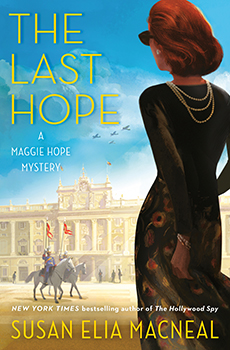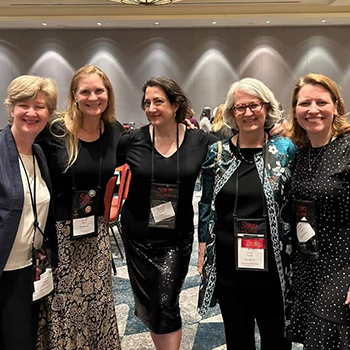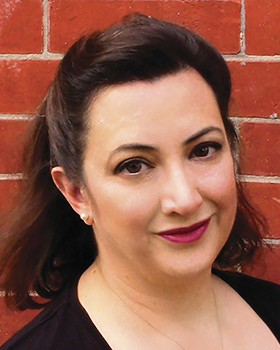

Features Susan Elia MacNeal
Lies, MI6 Spies, and a Massive Lego Typewriter
The Big Thrill Interviews New York Times Bestselling Author Susan Elia MacNeal
By Susan Goldenberg

It’s early 1944. The Allies are gaining the upper hand against Nazi-run Germany in the Second World War, but they are concerned that the Germans have a world-ending atomic bomb in development. This actual situation is the underpinning of THE LAST HOPE, the 11th book in bestselling New York City author Susan Elia MacNeal’s internationally successful Second World War espionage thriller series featuring super-spy Maggie Hope. At first, Maggie was a secretary to Winston Churchill; now she’s a major in British Intelligence.
There are over 1.2 million copies of the series’ books in print and audio, numerous foreign translations, and the series has been optioned for television development. “In an ideal world, I’d like Emma Stone to be Maggie and Kit Harrington her lover John Sterling,” Susan says. She’s won a Barry Award and been nominated for a slew of other crime-writing prizes.
Susan writes about Maggie’s call-back: “She recognized the feeling—excitement with a side of terror—and realized she’d missed it, missed going on missions, what she’d come to think of as work.” She’s asked by Kim Philby, then in real life MI6’s overseer of spying in Spain and Portugal: “Have you ever killed a man?” “You know I have,” she replies. “We have our eyes on a target,” he says. The target is German physicist Werner Heisenberg, thought to be developing a world-ending fission bomb for use in the war when on a trip to Portugal and Spain.
Maggie thinks: “I’m an intelligence agent. A code breaker. A secret agent. A spy. But an assassin?” Out of loyalty, she accepts, is given a tiny Beretta .25 pistol she can conceal in a purse or strap to her thigh under her dress, and two bullets, and instructed, “You have to be close and accurate.” She’s also given a cyanide tube resembling a lipstick to kill herself if captured.
THE LAST HOPE is an adroit mix of fiction and fact. Heisenberg and the plot against him were real. Regarding Philby, Susan told me in a Zoom chat: “I thought it would be fun for my fictional spy to deal with a real double-agent spy.” In the book, Philby is two-timing, scheming for Maggie to be killed. She intuits that he’s a mole for the Soviets but can’t convince Churchill.
Maggie’s mission takes her from London to Paris, Lisbon, and Madrid. There are murders. Along the way, she teams up with real-life French fashion designer Coco Chanel, who, on behalf of Germans seeking to end the war, gives Maggie a peace offer letter to hand-deliver to Churchill. There actually was such a letter, and Chanel was an intermediary. Maggie tells Chanel that Churchill will toss the letter into the fireplace. Recent biographies of Chanel call her a Nazi collaborator. “Chanel was an incredibly cold woman,” Susan says, “which is why I introduce her washing her hands in ice-cold rose water.”
Susan adds to the verisimilitude by writing that at the Ritz Hotel in Paris, there were both peach-toned towels and lighting in guest rooms (which owner César Ritz regarded as more flattering than white). She also included violet-flavored sweets, which were the rage in Spain, and “French letters,” which were was the euphemism for condoms.
“Would you have liked to be a spy?” I asked Susan.
“I’m not athletic enough to be out in the field, but I think I could do well at desk-job intelligence gathering,” she replied.
The spark for the series was a tour Susan took of the British government’s top-secret underground tunnel complex of war planning offices concealed underneath pavement in central London. She researched popular names for baby girls in 1915, the year of birth she chose for her protagonist spy. “Margaret was one of the top three. Because it sounds old-fashioned, I used ‘Maggie,’ which sounds young and vibrant.” For a surname, she looked up those of famous Britons, selecting “Hope” from British-born star Bob Hope and because hope was vital during the war, and ‘John Sterling’ because he’s of sterling character.”
Maggie is red-haired “to make her stand out from the black, white, and grey of Whitehall, London’s government district.” She’s a mathematical whiz, but Susan modestly says she isn’t. “I’m incredibly lucky to have friends gifted in maths and sciences.”

At Malice (taken by Susanna Calkins, with Mariah Fredericks, Karen Odden, Robin Agnew, and Susanna.)
Susan wrote her first Maggie book, Mr. Churchill’s Secretary, as a stand-alone. Random House realized the potential for a series and signed her to a two-book deal with a commissioned sequel, Princess Elizabeth’s Spy. “I’ll be forever grateful for the suggestion.” Both books were published in 2012. Susan was an editorial assistant at Random House, assistant editor at Viking Penguin, and associate editor and staff writer at Dance Magazine in New York City before switching sides and becoming an author. “I love being edited. I appreciate what editors do.” She recalls that her initial editor, Kate Miciak, advised: “It’s not true crime; don’t be too gory. Less is more. A hint is more powerful.” Susan remains friends with the now-retired Kate.
Susan will be parting ways with Maggie. She brushes away as “glib” her saying not so long ago that there would be six more in the series, three per each remaining year of the war. “You’re abandoning her,” I exclaimed in mock horror. “I felt guilty at first,” she admitted, then explained, “I’d covered all the themes and wrapped up a lot of history. Maggie got her hopeful ending. I want to do more things.” Another reason: she’s moved to Minotaur Books, “starting over as their author.” She’s in the process of writing a stand-alone thriller set in London in 1966 and a new mystery series set in New York City in the late fifties.
But the ending of THE LAST HOPE doesn’t say a final farewell to Maggie. “I would love to come back to her someday,” Susan says.
Maggie drinks pink gins, but since Susan enjoys concocting cocktails, I asked what else she might serve Maggie if she came for dinner. “Campari because it’s very red.” (Like Maggie’s hair.) John Sterling? “A single malt Scotch man.”
Susan and her husband, Noel MacNeal, an Emmy award-winning puppeteer and director, will celebrate their 25th wedding anniversary this coming November 6. They met at a New York City a cappella singing competition in which mutual friends were performing.
Briefly:
• Susan does most of her writing sitting cross-legged on the living room sofa.
• She uses her son’s room as an office when he’s away at college; vacates it when he’s home.
• It took the two of them “a couple of weeks” to assemble a Lego typewriter—2,000 pieces—gifted her by a friend upon the publication of Maggie Hope #10.
• For a year after graduating university, she worked for novelist John Irving, transcribing what he wrote on his manual typewriter into a computer and doing errands, such as picking up dry cleaning. “From watching him, I learned to treat writing fiction as a job, putting in eight hours a day, every day, like any other job.”
• For a “pleasurable change of pace,” she reads Alice Hoffman’s witchcraft novels. “Beautiful, poetic,” she says.
The Big Thrill Interviews New York Times Bestselling Author Susan Elia MacNeal
- Graham Moore - May 23, 2024
- Susan Elia MacNeal - May 23, 2024
- Chanel Cleeton - April 25, 2024

